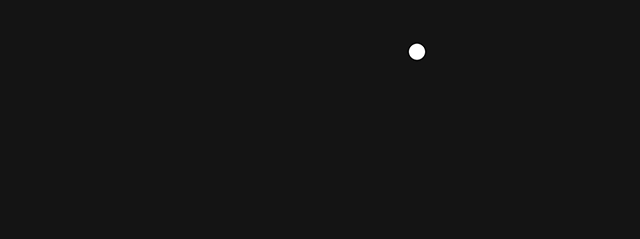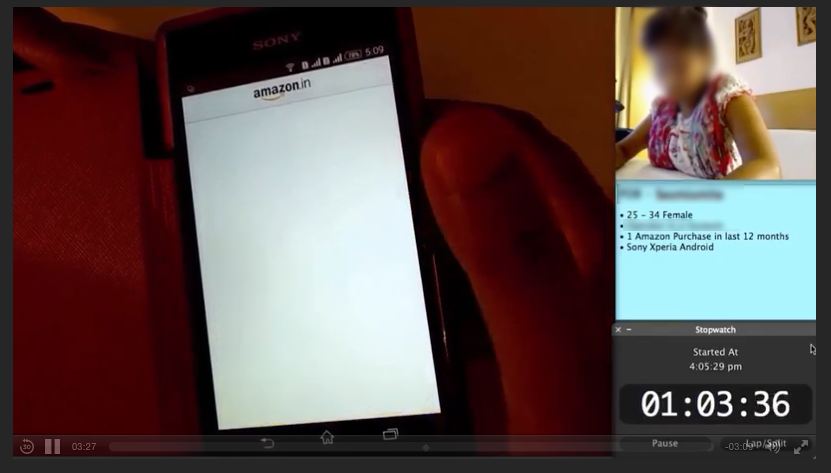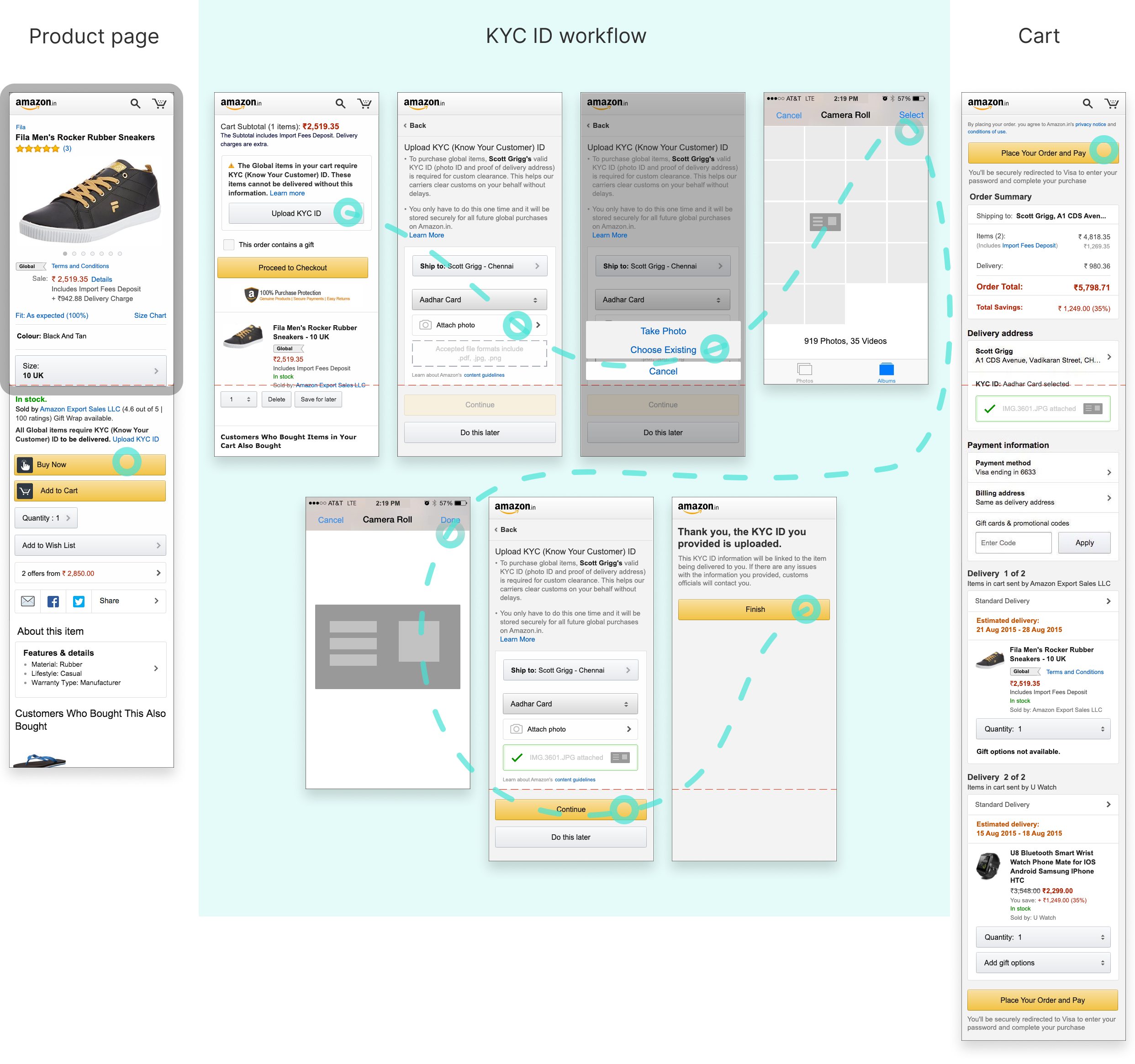Amazon - International Expansion Team
Boosted user trust and B2C international conversion rates for customers in India, Brazil and Mexico through better UX
I led UX research and design strategy, partnering cross-functionally and across countries to conduct user-centered ethnographic research, gaining regional insights into user perspectives, expectations, and purchase path priorities. Applying these insights, I designed tailored international B2C solutions for Amazon customers in India, Brazil, and Mexico, boosting customer trust and driving international conversion growth.
Timeframe: May '15 – Nov. '15
Team: UX Designer (Me), 3x PMs, 5x Engineers
My work: Research, Mobile-first, Enterprise UX, E-commerce
* This case study presents a workstream that was similar for all countries, but I’ve decided to limit images, focusing specific details to the Amazon India workstream, and present through the Amazon STAR (Situation, Task, Action, Result) method. 🙂
SITUATION:
In 2015 Amazon was expanding its online marketplace in India, Mexico and Brazil. Telemetry showed customers actively searching and browsing, with some entering the purchasing funnel but many abandoning before checkout.
In India, the push to compete with powerful local e-commerce giants and build long-term customer loyalty was central to Amazon’s strategy, aiming to make it the company’s largest market outside the US.
In parallel, Amazon launched full retail operations in Mexico in June 2015 with Amazon.com.mx and expanded its footprint in Brazil, Latin America’s largest economy. This UX work was pivotal in strengthening customer trust and engagement, fueling growth and market gains across all three regions.
Partnered with Product Management, Support, Engineering, and localized Researchers, and led iterative customer research studies. I combined qualitative ethnographic research insights with telemetry-driven metrics to gain a more holistic, customer-centered perspective, synthesizing findings and socializing them broadly to secure cross-functional stakeholder alignment on what was causing abandonment. Through this cross-functional collaboration, we defined the task/goal (ideal user experience), and action/process that would enable us to achieve these results/experiences.
TASK/GOAL:
PM goal: more details included in press release and FAQ documents (Amazon Confidential)
Our overall vision is to provide customers in India access to all international products sold by Amazon, 3P merchants and our subsidiaries from the rest of the world.
Enhance customer experience and selection
Make Amazon.in marketplace more successful
UX goal:
Customers across regions will find greater clarity and experience higher confidence through Amazon’s search, browse, selection, product purchase funnels, and order confirmation experiences - leading to less abandonment and higher conversion rates.
-
Build a process for localized research that captures authentic customer insights.
Ensure research consistency and quality across markets through repeatable, test methods.
Increase understanding of how to ensure research is conducted in users native languages.
-
Build a deep regional understanding of user behavior, cultural expectations, and regulatory factors that influence purchasing decisions.
Identify and remove friction within search, browse, selection, and purchase workflows to align the experience with localized user needs.
-
Foster a shared understanding and accountability through collaborative, participatory research and design activities that build cross-team momentum
Translate collaboration into actionable design direction that balances global consistency with regional nuance.
-
Drive measurable conversion improvements through ongoing iterative testing and data-driven refinement.
Foster a cross-functional culture of continuous evaluation and iteration to sustain high-quality user experiences across releases.
ACTION/PROCESS:
Workshopped options to plan for this broad, multi-country, cross-functional initiative, and all its moving parts, defining the UX Outcome above (we called “goals”), and providing introductions to the multi-partner team.
We focused on a mobile-first strategy.
Through this workshop, I learned that across demographics, most customers were utilizing the Amazon marketplace on mobile devices. After defining the mobile version, I moved on to the tablet and desktop designs.
Created a script to be utilized by research partners in all countries. For India, we conducted a study in New Delhi, partnering with localized researchers who administered the test and recorded a video for each participant, sharing verbal feedback, facial reactions, the customer’s screen view, and a brief user profile.
We had 8 participants in the India baseline study:
4 female | 4 male
new | infrequent | frequent customers
Age: 5 = 25-34 years old | 3 = 34-50 years old
Successfully navigating the prototype (success was not required):
6 succeeded | 2 failed
The most important aspect of a purchasing decision for customers in India was being able to easily understand product pricing.
Users were frustrated when purchasing items and realizing only after submitting orders that a required Import Fee Deposits (IFDs) were being added to their purchases. Import Fees Deposits are a preliminary estimate of the customs duties, taxes, and other fees that can add a substantial additional price at checkout for international orders.
Users’ sentiment in India was that all product prices needed to include this additional required fee and display the full price prominently, making it apparent that the IFD was already included.
Research across all countries revealed significant regional differences in shopping preferences and priorities that affected user trust, and ultimately Amazon conversion rates. This is detailed in the results below.
⭐️ Late-breaking addition to requirements…
A requirement was introduced for international Amazon purchases, involving a process of uploading an identification known as Know Your Customer (KYC) Identification to ensure effective product delivery. This initiative for sellers and merchants became more prominent around 2015, aligning with the company's global expansion and the increasing regulatory requirements in various markets.
Acceptable KYC ID Types:
Driver’s License
Passport Number
Voter ID
The KYC ID requirement was integrated into the purchase funnel workflow, and surfaced after customers clicked “Buy now” from their cart. I created a prototype and we took this addition through a research iteration to validation test with Indian users (showcased in the mobile comps below).
These mobile, tablet, and desktop change annotations below are a great explanation of the final design, highlighting the important Import Fees Deposit information, with a “Details” link available for a total price breakdown. These annotated comps were utilized in Product Management and Engineering discussions for team transparency and aided in implementation.
Mobile workflow change annotations -
Throughout each of these workflows, the Import Fees Deposit and price breakdowns are highlighted for customer visibility and clarity
Tablet examples -
Additional pricing options across marketplace sellers are showcased in the desktop workflow below. The Bluetooth Smart Wrist Watch is a domestic product and has multiple prices to choose from, each including IFD (Import Fees Deposits)within the total price breakdown.
Desktop workflow change annotations -







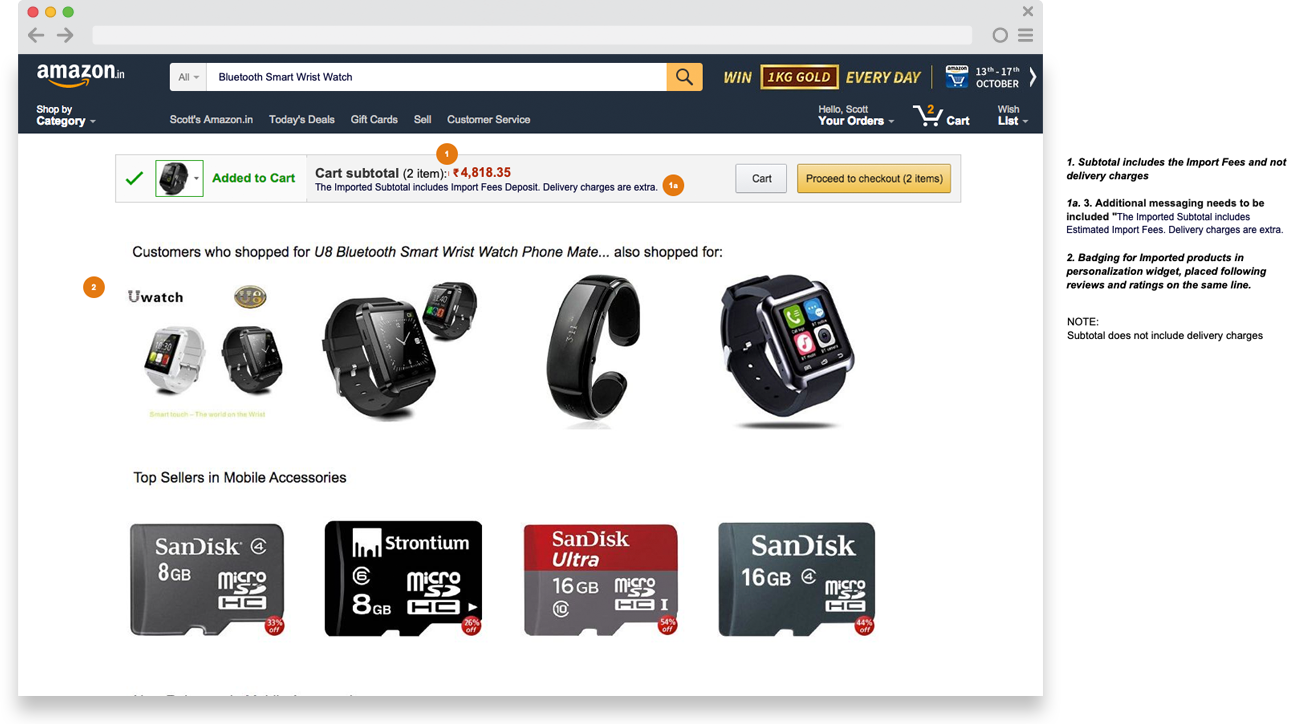




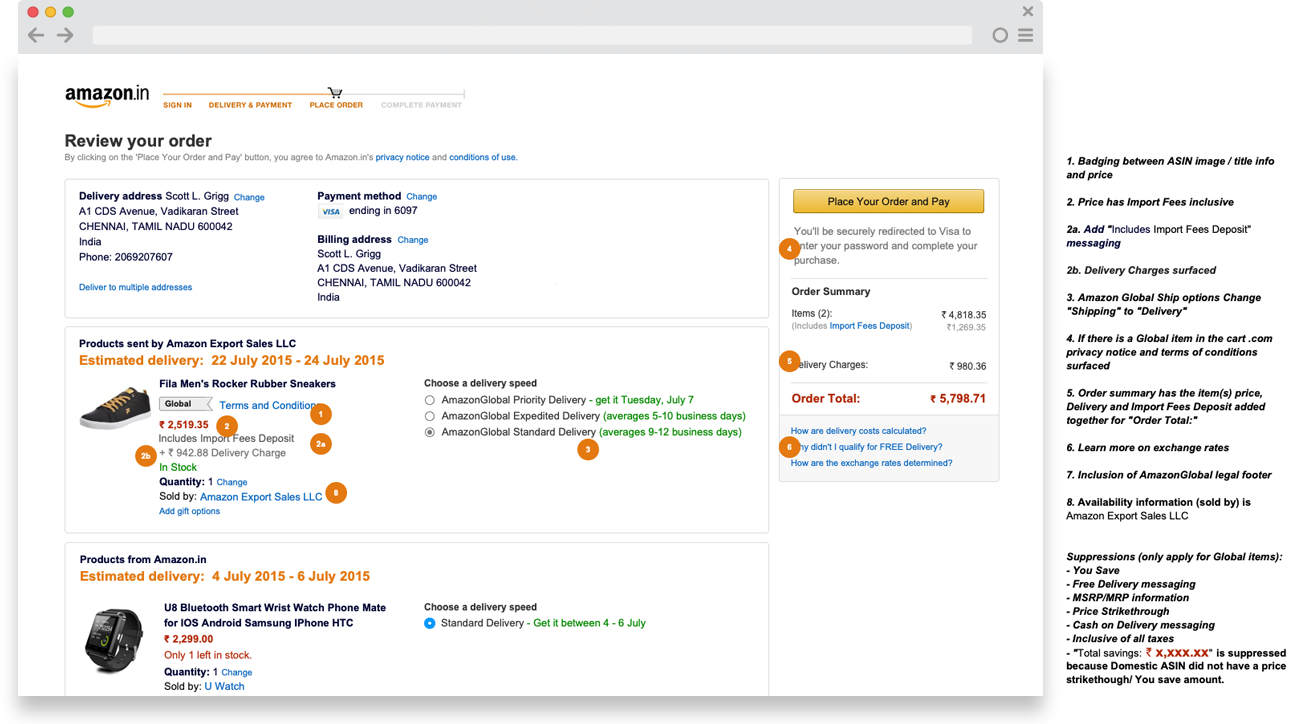





RESULTS:
I identified country-specific, customer-focused optimizations for the Amazon marketplace, gathering detailed information about customers’ most important product purchasing concerns, then designed solutions that prioritized what mattered most for each regional customer experience, while also aligning with Amazon business owner objectives in each country.
These personalized shopping experiences not only increased customer trust but also led to significant improvements in international Amazon marketplace conversion rates in each country, ultimately boosting Amazon’s groundbreaking international expansion success in Asia and Latin America.
This work contributed to the Amazon.in bottom line from March 2015 ($153.68 million USD revenue) to March of 2016 ($342.1 million USD revenue) and a revenue increase of 122.7%.
-
Established a scalable, repeatable research process that enabled teams to conduct localized studies with consistent quality and structure.
Partnered with local researchers in each region to localize the usability studies, using translated scripts and adjusting the prototype to surface products that were regionally relevant and presented in users’ native languages.
Gained Region specific knowledge of what was most importatn to users and how to align the purchase path to meet these needs.
Indian customers required the availability of total price clarity, including fees and product selections across marketplace sellers
Brazilian customers valued options for payment installments
Mexican customers prioritized product availability
* I passed my baseline usability script to a team that was focused on Chinese users across provinces, but had no more interaction with the workstream outside of understanding that Chinese users highly valued product authenticity.
-
Reduced friction and confusion in search, selection, and purchase workflows across multiple regions.
Increased purchase completion rate, user trust and satisfaction by incorporating more informative product and pricing details that aligned with localized user expectations.
-
Strengthened collaboration between research, design, and engineering through active participation in usability testing and synthesis sessions.
Increased efficiency and cohesion in product decision-making through shared understanding of user insights.
Delivered globally consistent experiences with regionally relevant variations informed by collaborative design direction.
-
Improved user task completion rates and conversion, through continuous testing and data-driven design refinement.
Established an ongoing feedback loop between research, design, and product to sustain quality across releases and across regions.
Embedded a culture of iterative learning and validation, improving team responsiveness to emerging user needs.
